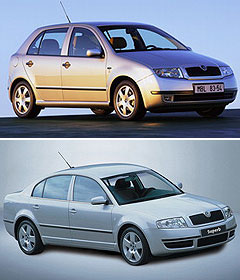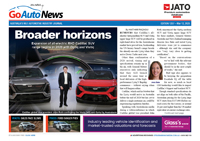Future models - Skoda - OctaviaSkoda's Australian Czech-mate!Czech models: Performance RS version of Octavia medium sedan (above) was launched at Frankfurt, while small Fabia hatch (below, top) and large Superb sedan (below, bottom) date back to 1999 and 2001 respectively. Volkswagen's Czech-built Skoda brand will be introduced Down Under next June22 Sep 2005 EUROPEAN car-maker Skoda has confirmed it will finally launch on to the Australian market next June after several years of speculation. Skoda chairman and chief executive officer, Detlef Wittig, confirmed to GoAuto at last week’s Frankfurt motor show that the VW-owned, Czech-manufactured cars would launch with the mid-size Octavia. The Octavia hatch, at 4572mm long and with a wheelbase of 2578mm, will go head-to-head with the Mazda6, Honda Accord and Holden Vectra. Both petrol and diesel models will be sold, with the flagship model being the turbocharged 2.0-litre, six-speed RS Octavia, which was unveiled at Frankfurt. The Octavia models will be followed three-to-six months later with the small Fabia and then the more luxurious Superb. Although cognisant of the huge marketing cost to re-establish a brand here, Mr Wittig said that by utilising VW’s logistical and technical support it would be possible, but as "far as the retail network is concerned, it will be separate". Skoda will sell the brand as a value proposition, borrowing aspects of the UK marketing and launch strategy adopted for the brand when it launched the Octavia there in 1998. "Our strategy will be similar to the UK," he said. With more than 27 years’ experience with VW in North America, Asia and Europe, Mr Wittig believes the time is right for Skoda to return to Australia. Skoda has long had desires to re-establish in Australia under the VW banner. The Czech car-maker contributed $US65 million to VW’s net profit last year and is one of the fastest-growing brands within the VW Group. Mr Wittig said the challenge for any brand establishing in Australia was brand recognition. "In any case, that’s the challenge," he said. "The initial marketing investment certainly plays a major role in the feasibility study. But I think we can manage." Skoda’s worldwide sales forecast this year is almost 500,000, a modest result compared to some European car-makers. Mr Wittig said the brand had an intermediate goal to achieve 600,000 sales within the next two to three years, however, he admitted the company would remain a niche player in global terms. "We have analysed our potential for the Australian market and I think we have arrived at a positive result," Mr Wittig said. As the volume seller, the Octavia would also prepare the image of the brand for the other models to follow, he said. Although pricing and specifications of the Australian-bound cars are still to be finalised, the Skoda brand will be priced under equivalent VW models. This means the Fabia, which is available in Europe as a sedan, hatch or wagon, will come in under the $16,990 to $19,990 VW Polo while the Octavia could sit between $30,000 and $40,000. The Superb could be a sub-$50,000 car. Australia had come back on to the horizon with Skoda on the back of strong growth in Europe and a desire to "look east", as Mr Wittig put it. The brand is embarking on a push into the ASEAN markets, including Australia.  "We have an area strategy that says we go further east of the Czech Republic and further east doesn’t just mean eastern Europe," he said. "We have an area strategy that says we go further east of the Czech Republic and further east doesn’t just mean eastern Europe," he said.Skoda will soon start building cars in Shenzhen, China, which will be its biggest plant outside the Czech Republic. However, Skodas destined for Australia will be built at the three Czech Skoda plants. The main plant is in Mlada Boleslav, where the Octavia is built. The low brand recognition in Australia for the Czech car-maker does not faze Mr Wittig. "I don’t know whether it’s negative. All our research says that we are rather unknown, which is a good chance to fill a hole with a positive image," he said. However, he did point out that there was a dedicated, albeit small, following for the brand here. "There is a Skoda fan club existing in ustralia, for whatever reason, (and) they have contacted us," he said. Skoda, which is known in Europe as the "value" brand in the VW Group, would pursue the same image when launched Down Under. "Skoda is a value brand,' he said. "It’s by no means cheap but what we normally combine with the market is that they are spacious, roomy and comfortable with high quality," he said. Although the Fabia and Octavia would offer a petrol and diesel choice, Mr Wittig said the Superb was likely to be offered as a petrol-engine car only. In Europe, the Octavia is available with several petrol and diesel engines, but Australia is likely to see the 110kW 2.0-litre petrol and perhaps the 77kW 1.9-litre TDi and 103kW 2.0-litre TDi. The Fabia comes with a 74kW 1.4-litre 16-valve petrol or 74kW 1.9-litre TDi. Mr Wittig said the Superb sold in Australia would be the next-generation incarnation of the current series. The current luxury Superb comes with two petrol or three diesel engines, but Australia may only see the 142kW 2.8-litre 30-valve V6 and perhaps the 120kW 2.5-litre TDi V6. The Superb comes with a full range of luxury features, including sunroof with solar panels, dual front, side and curtain airbags, 17-inch alloys, heated front seats, mechanical rear window shade, multi-function steering wheel, eight-speaker CD stereo and dual exhausts. Seat puts Australia into the ‘too hard’ basket - for nowSKODA may be heading back but sister VW Group brand Seat has no plans to return here in the short-term.The company’s chairman, Dr Andreas Schleef, told GoAuto in Frankfurt last week that the Spanish-based car-maker was concentrating on restructuring its European business before seeking new export markets. Seat cars were last sold in Australia in the mid-1990s but start-up costs and marketing issues dogged the brand. "At the moment we are more or less a European-based company," Dr Schleef said. "Product-wise your country (Australia) could be attractive but I have to be honest at the moment – there is no decision yet because we have to make Europe work with our restructuring." If Seat were to return it would launch next-generation models of its current range to meet emission and safety standards – "so this would give you a time frame of up to five years", Dr Schleef said. He identified possible starters as the next-generation Leon and Altea models, but ruled out the Ibiza as "a little too small for Australia". Roughly 90 per cent of Seat volume is sold in Europe with smaller exports markets in Mexico, South America and North Africa. Dr Schleef said Seat could not be all things to all markets as "the VW group has different brands to cover that". All future models Alfa Romeo Alfa Romeo Abarth Abarth Alpine Alpine Alpina Alpina Audi Audi Aston Martin Aston Martin BMW BMW Bentley Bentley Chery Chery Brabham Brabham Chrysler Chrysler Chevrolet Chevrolet Cupra Cupra Citroen Citroen DS DS Dodge Dodge Fiat Fiat Ferrari Ferrari Foton Foton Ford Ford Great Wall Great Wall FPV FPV Haval Haval GWM GWM Honda Honda Holden Holden Hummer Hummer HSV HSV Infiniti Infiniti Hyundai Hyundai Jaguar Jaguar Isuzu Isuzu Kia Kia Jeep Jeep Land Rover Land Rover Lamborghini Lamborghini Lexus Lexus LDV LDV Mahindra Mahindra Lotus Lotus Mazda Mazda Maserati Maserati Mercedes-AMG Mercedes-AMG McLaren McLaren MG MG Mercedes-Benz Mercedes-Benz Mitsubishi Mitsubishi Mini Mini Opel Opel Nissan Nissan Peugeot Peugeot Pagani Pagani Proton Proton Porsche Porsche Renault Renault Ram Ram Rover Rover Rolls-Royce Rolls-Royce Skoda Skoda Saab Saab SsangYong SsangYong Smart Smart Suzuki Suzuki Subaru Subaru Toyota Toyota Tesla Tesla Volvo VolvoOctavia pricing
Motor industry news |
Click to shareSkoda modelsResearch Skoda All future models Alfa Romeo Alfa Romeo Abarth Abarth Alpine Alpine Alpina Alpina Audi Audi Aston Martin Aston Martin BMW BMW Bentley Bentley Chery Chery Brabham Brabham Chrysler Chrysler Chevrolet Chevrolet Cupra Cupra Citroen Citroen DS DS Dodge Dodge Fiat Fiat Ferrari Ferrari Foton Foton Ford Ford Great Wall Great Wall FPV FPV Haval Haval GWM GWM Honda Honda Holden Holden Hummer Hummer HSV HSV Infiniti Infiniti Hyundai Hyundai Jaguar Jaguar Isuzu Isuzu Kia Kia Jeep Jeep Land Rover Land Rover Lamborghini Lamborghini Lexus Lexus LDV LDV Mahindra Mahindra Lotus Lotus Mazda Mazda Maserati Maserati Mercedes-AMG Mercedes-AMG McLaren McLaren MG MG Mercedes-Benz Mercedes-Benz Mitsubishi Mitsubishi Mini Mini Opel Opel Nissan Nissan Peugeot Peugeot Pagani Pagani Proton Proton Porsche Porsche Renault Renault Ram Ram Rover Rover Rolls-Royce Rolls-Royce Skoda Skoda Saab Saab SsangYong SsangYong Smart Smart Suzuki Suzuki Subaru Subaru Toyota Toyota Tesla Tesla Volvo VolvoOctavia pricing
Motor industry news |














Facebook Twitter Instagram